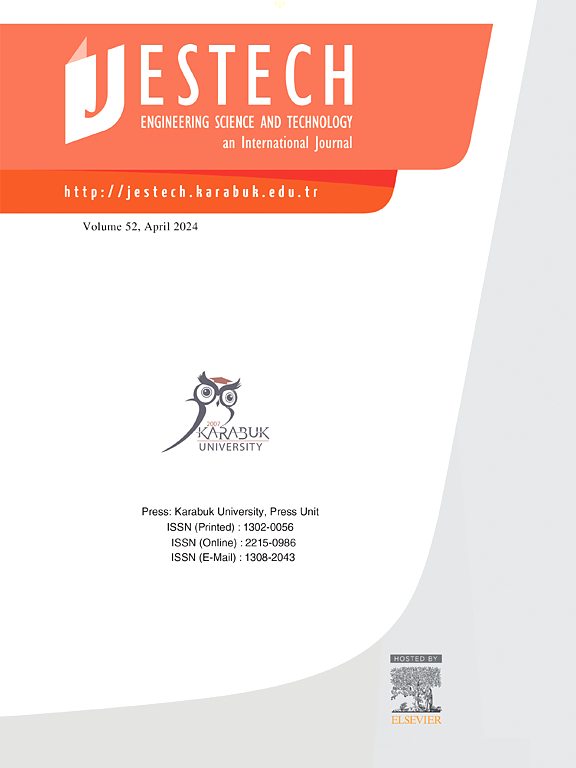基于哈夫曼编码的安全图像隐写数据约简和四组隐写逻辑
IF 5.4
2区 工程技术
Q1 ENGINEERING, MULTIDISCIPLINARY
Engineering Science and Technology-An International Journal-Jestech
Pub Date : 2025-03-18
DOI:10.1016/j.jestch.2025.102033
引用次数: 0
摘要
确保安全的数据传输对于保持机密性至关重要,并且变得越来越重要。隐写术是一种在数字图像中嵌入秘密信息的技术,它被广泛用于保护敏感数据免遭未经授权的公共网络访问。然而,现有的隐写算法经常面临有效载荷容量、图像质量和安全性之间的重大权衡。嵌入大量数据会导致明显的图像质量失真,从而破坏该技术的有效性。此外,目前的方法缺乏对不同覆盖介质的适应性,并且在增加嵌入容量的情况下难以保持可逆性和高视觉质量。为了解决这些挑战,本研究提出了一种新的隐写算法,该算法集成了两个关键创新:(1)通过将隐写图像分割为四幅图像来增强隐写图像质量,减少浓度引起的失真;(2)通过无损压缩通过霍夫曼编码优化数据嵌入,最大限度地减少嵌入引起的失真,同时最大化有效载荷容量。实验结果表明,在10 ~ 100 KB的有效载荷范围内,该方法在未加密时的PSNR值为75.793 ~ 44.997 dB,加密后的PSNR值为51.159 ~ 44.316 dB,具有较高的视觉保真度。这些值超过可接受的图像隐写的30db阈值,确保最小的感知失真。此外,SSIM一直保持在0.98以上,表明隐写图像具有很强的结构保存能力。与现有方法的对比分析表明,该方法在嵌入容量、结构相似指数度量(SSIM)和峰值信噪比(PSNR)等方面均优于隐写图像。本文章由计算机程序翻译,如有差异,请以英文原文为准。

Huffman coding-based data reduction and quadristego logic for secure image steganography
Ensuring secure data transmission is critical for maintaining confidentiality and has become increasingly important. Steganography, which embeds secret information within digital images, has been widely explored to safeguard sensitive data from unauthorized access over public networks. However, existing steganographic algorithms often face a significant trade-off between payload capacity, image quality, and security. Embedding large amounts of data can cause noticeable distortion in image quality, undermining the technique’s effectiveness. Furthermore, current methods lack adaptability to diverse cover media and struggle to maintain reversibility and high visual quality under increased embedding capacities. To address these challenges, this study proposes a novel steganographic algorithm integrating two key innovations: (1) Enhancement of stego image quality via stego image’s segmentation into four images, reducing concentration-induced distortions, and (2) optimization of data embedding through Huffman coding through a lossless compression minimizing the embedding-induced distortions while maximizing payload capacity. The experimental results show that the proposed method achieves high visual fidelity, with PSNR values ranging from 75.793 dB to 44.997 dB without encryption and from 51.159 dB to 44.316 dB with encryption for payloads between 10 KB and 100 KB. These values exceed the 30 dB threshold for acceptable image steganography, ensuring minimal perceptual distortion. Additionally, the SSIM remains consistently above 0.98, indicating strong structural preservation of stego images. Comparative analysis with existing methods confirms that the proposed approach outperforms in embedding capacity, structural similarity index measure (SSIM), and peak signal-to-noise ratio (PSNR), reflecting the stego images’ quality.
求助全文
通过发布文献求助,成功后即可免费获取论文全文。
去求助
来源期刊

Engineering Science and Technology-An International Journal-Jestech
Materials Science-Electronic, Optical and Magnetic Materials
CiteScore
11.20
自引率
3.50%
发文量
153
审稿时长
22 days
期刊介绍:
Engineering Science and Technology, an International Journal (JESTECH) (formerly Technology), a peer-reviewed quarterly engineering journal, publishes both theoretical and experimental high quality papers of permanent interest, not previously published in journals, in the field of engineering and applied science which aims to promote the theory and practice of technology and engineering. In addition to peer-reviewed original research papers, the Editorial Board welcomes original research reports, state-of-the-art reviews and communications in the broadly defined field of engineering science and technology.
The scope of JESTECH includes a wide spectrum of subjects including:
-Electrical/Electronics and Computer Engineering (Biomedical Engineering and Instrumentation; Coding, Cryptography, and Information Protection; Communications, Networks, Mobile Computing and Distributed Systems; Compilers and Operating Systems; Computer Architecture, Parallel Processing, and Dependability; Computer Vision and Robotics; Control Theory; Electromagnetic Waves, Microwave Techniques and Antennas; Embedded Systems; Integrated Circuits, VLSI Design, Testing, and CAD; Microelectromechanical Systems; Microelectronics, and Electronic Devices and Circuits; Power, Energy and Energy Conversion Systems; Signal, Image, and Speech Processing)
-Mechanical and Civil Engineering (Automotive Technologies; Biomechanics; Construction Materials; Design and Manufacturing; Dynamics and Control; Energy Generation, Utilization, Conversion, and Storage; Fluid Mechanics and Hydraulics; Heat and Mass Transfer; Micro-Nano Sciences; Renewable and Sustainable Energy Technologies; Robotics and Mechatronics; Solid Mechanics and Structure; Thermal Sciences)
-Metallurgical and Materials Engineering (Advanced Materials Science; Biomaterials; Ceramic and Inorgnanic Materials; Electronic-Magnetic Materials; Energy and Environment; Materials Characterizastion; Metallurgy; Polymers and Nanocomposites)
 求助内容:
求助内容: 应助结果提醒方式:
应助结果提醒方式:


